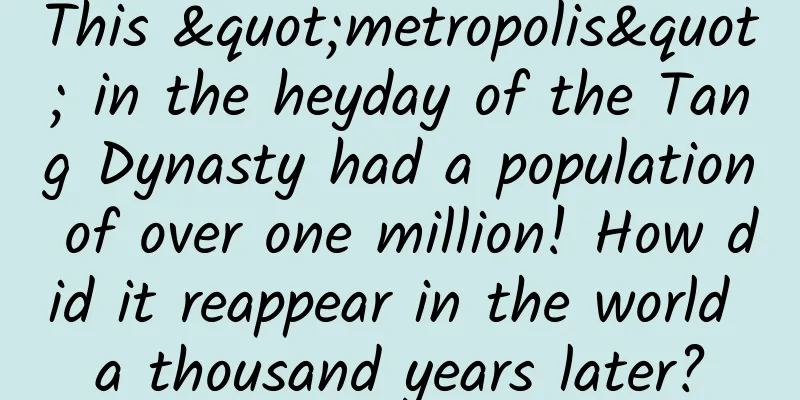This "metropolis" in the heyday of the Tang Dynasty had a population of over one million! How did it reappear in the world a thousand years later?

|
On December 11, 1961, the ruins of a metropolis with a population of one million more than a thousand years ago were unearthed in my country. This metropolis was the famous Tang Dynasty capital Chang'an. The excavation of the Tang Dynasty Chang'an City ruins 63 years ago was not only a major discovery in the history of Chinese archaeology, but also an important event in the history of human civilization. It allowed people to re-recognize this once glorious capital, and revealed its glory and vicissitudes as a metropolis with a population of one million. At the same time, the application of modern technology has also provided strong support and guarantee for archaeological excavation and site protection. The Millennium City Reappears on Earth December 11, 1961, was an ordinary winter day, but it left a strong mark in the history of Chinese archaeology. In Xi'an, Shaanxi Province, the ruins of a metropolis with a population of one million that had been dormant for more than a thousand years, the Tang Dynasty Chang'an City, finally reappeared in the world thanks to the hard work of archaeologists. This discovery not only shocked the archaeological community, but also attracted widespread attention and heated discussions at home and abroad. Chang'an City in the Tang Dynasty, as one of the most prosperous cities in the world at that time, is an outstanding representative of ancient Chinese civilization. Since it was built as the capital in the first year of Emperor Gaozu of the Tang Dynasty (618), Chang'an City has experienced 289 years of glory and witnessed the rise and fall of the Tang Dynasty. However, as time passed, this once glorious capital was gradually buried in the dust of history, leaving only a few relics for future generations to pay tribute to. The excavation work began in the late 1950s. With the increasing awareness of national cultural relics protection and the continuous advancement of archaeological technology, archaeologists began to conduct systematic exploration and excavation in the Xi'an area. In 1957, the Institute of Archaeology of the Chinese Academy of Sciences organized a special Tang City excavation team and started a large-scale excavation. After more than four years of hard work, the general outline of the site has now been revealed. On December 11, 1961, the archaeological team discovered the ruins of the city wall of Chang'an City in the Tang Dynasty at a construction site in the suburbs of Xi'an. From the remains of the city layout, palaces, streets, and streets that have been excavated, we can imagine the grand scene of thousands of households and the bustling traffic in the city at that time. This discovery is like opening a door to the depths of history, allowing modern people to glimpse the glory and magnificence of the thousand-year-old capital. The splendor and vicissitudes of ancient metropolises The excavation of the ruins of Chang'an City in the Tang Dynasty not only allowed people to re-recognize this once glorious capital, but also revealed its glory and vicissitudes as a metropolis with a population of millions. The layout of Chang'an City is rigorous and magnificent. The entire city is divided into three parts: the outer city, the imperial city and the palace city. The outer city has a circumference of about 36.7 kilometers and an area of about 84 square kilometers. It was one of the largest cities in the world at that time. The city wall is tall and solid, built of rammed earth, and the outer wall is covered with blue bricks, which is magnificent. The streets in the city are wide and straight, crisscrossing, forming a chessboard-like road network structure. There are numerous palaces, government offices and mansions in the imperial city and palace city. Among them, Daming Palace, Taiji Palace and Xingqing Palace are the three major palace complexes in the Tang Dynasty. They are large in scale and exquisite in architecture, and were the center of political, cultural and religious activities at that time. In addition, there are a large number of markets, temples and houses in Chang'an City, forming a prosperous commercial area and a bustling life scene. During the archaeological excavation, a large number of cultural relics and remains were unearthed, including pottery, porcelain, bronze, iron, gold, silver, jade and other objects, as well as murals, sculptures, stone carvings and other artworks. These cultural relics not only show the superb craftsmanship of the Tang Dynasty, but also reflect the political, economic, cultural and religious conditions of the society at that time. It is worth mentioning that archaeologists discovered a large-scale drainage system from the Tang Dynasty in Chang'an City. The system consists of open and underground channels, seepage wells and pools. It is ingeniously designed and fully functional, effectively solving the city's drainage problems. This discovery not only proves the scientific and advanced nature of Tang Dynasty urban planning, but also provides valuable experience and inspiration for future generations. Modern technology helps archaeological excavation and site protection Modern technology has played an indispensable role in the excavation of the Tang Dynasty Chang'an City Ruins. With the continuous advancement of archaeological technology and the application of modern scientific and technological means, archaeologists have been able to gain a deeper understanding of the historical features and cultural connotations of this thousand-year-old capital. During the archaeological excavation process, archaeologists used a variety of modern scientific and technological means, such as remote sensing technology, geophysical detection technology, geographic information system, etc. The application of these technologies not only improved the efficiency and accuracy of archaeological excavation, but also enabled archaeologists to conduct in-depth exploration and research on the site without destroying the site. In addition, modern technology has also provided strong support for the protection and restoration of the site. In the process of protecting the Chang'an City ruins, archaeologists have adopted a variety of technical means, such as chemical reinforcement, physical support, environmental control, etc., to ensure the stability and safety of the site. At the same time, they also use digital technology to conduct three-dimensional scanning and modeling of the site, which makes it possible for the permanent preservation and display of the site. Nowadays, with the development of digital technology, the virtual restoration of the Tang Dynasty Chang'an City Ruins has also made significant progress. By collecting and analyzing a large amount of historical documents and archaeological data, Chinese archaeologists have used computer technology to virtually restore the layout, architecture and landscape of Chang'an City. This achievement not only allows people to more intuitively understand the historical features and cultural connotations of Chang'an City, but also provides valuable cultural heritage and tourism resources for future generations. The excavation of the Tang Dynasty Chang'an City ruins not only has important historical and cultural value, but also has a profound impact on modern urban planning, architectural design and cultural heritage protection. Comprehensive from Xinhuanet, "Archaeological Notes of Tang Chang'an City" |
<<: Relying on yourself for everything is a sign of a person who has been hurt
>>: Manyi•Issue 219 | Facing hypothermia, come and get your "Warm Guardian Plan"
Recommend
How does the Foshan Financial Mini Program work? How to promote financial WeChat mini-programs?
With the development of mobile Internet, finance ...
Travel Frog Unity Game Reverse Modification--iOS Edition
I wrote an article analyzing Android C# scripts b...
When using WeChat Pay, remember to turn on these 4 switches to make the money in WeChat safer
While WeChat brings us convenience, it can also e...
Mom: Go ask whose college students put their suitcases like this? Netizen: Please see the comments section
Spring Festival is coming There is a strong festi...
surprise! Open an account for Double 12 Information Flow and receive RMB 6,000 in cash!
As the year draws to a close, the company's v...
400 million daily active users, covering more than 200 sub-industries, more than 40,000 active service providers, and the "Mini Program Economic Circle" has begun to take shape
On September 9, the WeChat special event "We...
The impact of anemia may be greater than you think! How to self-diagnose whether you have anemia?
Author: Han Bing, Chief Physician, Peking Union M...
Online operation strategy
The following is an outline of the content of thi...
Two cars on the elevated road were fighting and almost fell off the bridge! Expert: This is road rage
On the evening of May 24, a netizen posted a mess...
Nokia accuses Apple of infringing 32 technology patents
In the early morning of December 22nd, Beijing ti...
The “common face” of the “super shield”: Why do the return capsules of spacecraft look similar?
Every time you see the spacecraft's return ca...
54 lessons required for training managers: a learning map from training management to organizational development
54 lessons required for training managers: Learni...
Another new species has appeared! Why do rare animals and plants appear in Danxia Mountain?
Recently, the investigation team discovered a spi...
The most comprehensive analysis of the top 10 short video platforms including Bilibili and Tik Tok!
With the development of the network environment a...
Zhihu operation and promotion: How to quickly occupy the best promotion position on Zhihu?
The traffic matrix is accumulated, not achieved...









